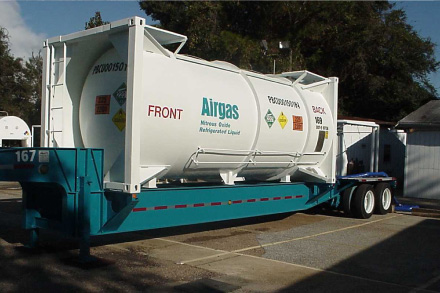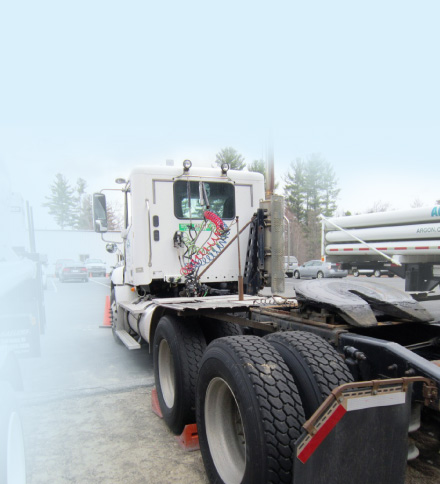
Responsibility:
Emission and Waste Reduction
Airgas produces a relatively small percentage of packaging waste because our primary product—industrial gases—is delivered in reusable cylinders or pumped directly from our trucks into on-site tanks. We do produce other forms of waste and our focus today is on eliminating harmful nitrous oxide emissions from the atmosphere and truck tires from our landfills.
Nitrous Oxide Emission Reduction
Nitrous oxide (N2O) is a greenhouse gas with nearly 300 times the global warming impact of carbon dioxide. Annually, Airgas produces and packages about 30 million pounds of this gas for sale to whipped cream manufacturers, electronics producers, and medical and dental customers. Most of this product is manufactured at our Pensacola, FL site where we recover and repurpose gas from the waste stream of a chemical plant. As part of the manufacturing process, a portion of the N2O is vented to the atmosphere, and cannot be economically reclaimed. In 2012, we vented approximately 20 percent of the overall production as "waste N2O" into the atmosphere. In 2013, we reduced that to 15 percent—a 25 percent improvement—by recirculating one vent stream back into the process, and in 2014 we formed an internal Airgas team and engaged an engineering firm to identify solutions to reduce N2O emissions even further.
Another source of N2O emissions is our fill plants where bulk quantities of N2O are transferred from trucks into refrigerated bulk tanks and, eventually, into cylinders for use by our customers. From 2013 to 2014, we decreased N2O "losses" at our fill plants from 12.1 percent to 10.5 percent, a reduction of 100 metric tons of emissions year over year. This was accomplished through equipment upgrades, identification and repair of leaks in the piping systems and increased monitoring of refrigeration levels to avoid pressure build-ups that could cause safety venting. Airgas has targeted an annual 1 percent reduction in fill plant N2O losses going forward.
N2O Emissions in Production Phase
(as percent of total production quantity)
2013 15%
2014 15%
N2O Emissions in Fill Phase
2013 12.1%
2014 10.5%
East Region: Reducing Emissions by Reducing Storage Tanks
In 2014, our East Region reduced N2O emissions by nearly 99 percent at its five fill plants. A team took inventory of the number of bulk tanks used to store refrigerated N2O and discovered it didn't need them all to keep up with customer demand. The team consolidated five production sites into two locations and installed upgraded equipment. Older tanks with defects were decommissioned, newer tanks were installed, and process lines were upgraded.
From the beginning of 2014 to the end of the year, the Region reduced its average monthly N2O losses from nearly 20,000 pounds to less than 500 pounds, and at the midway point in 2015 it's down to 250 pounds. The project is saving tens of thousands of dollars in lost product revenue—proof that reducing N2O losses is good for both business and the environment.

An Airgas bulk tank used to store refrigerated nitrous oxide (N2O)
East Region Monthly N2O Losses
(2014 N2O losses in pounds)
JAN 2014
20,000
DEC 2014
500

Tire Waste Reduction
At Airgas, we work to keep as much waste out of landfills as possible, and that effort begins with truck tires. Due to their large volumes and 75 percent void space, tires consume valuable real estate in landfills. They can also trap methane gases, which cause damage to the landfill liners that keep contaminants from polluting local surface and ground water.
Instead of disposing of our old tires, our first option is to send them back to the tire manufacturers for retreading and reuse. The tire companies shave off the old tread that wraps around the rubber and steel tire casing and replace it with a new tread. Not only are we keeping this rubber and steel out of the landfill, but studies show that retreads require 70 percent less energy and 68 percent less oil compared to new tire production. With more than 5,200 vehicles in Airgas' fleet—traveling more than 130 million miles annually—the environmental impact of this tire retread effort is substantial.
Our policy is to retread tires twice, giving them three life spans before they have to be disposed. The only exceptions are tires that are in a "steering position" on the truck or those that suffered damage to the casing. In 2014, we increased our percentage of retread tires, keeping more than 10,000 tires out of the waste stream.
Percentage of Retread Tires
(as percent of total purchased tires)
2013 74%
2014 84%
Scott Provencal: A Second Life
For Tires … Without a
Second Thought
Scott Provencal's motto when it comes to replacing tires is "retreads are required." With responsibility for nearly 500 vehicles, this fleet manager for our Northeast Region receives regular calls to approve the purchase of new tires—and his answer is always the same: "Unless there's a special situation, we order retreads on the trailers and the rear tires of all our trucks."
The use of retreads not only reduces waste, it reduces costs. "Properly maintained, a retread tire can last as long as a new tire and cost up to 40 percent less," says Provencal.
